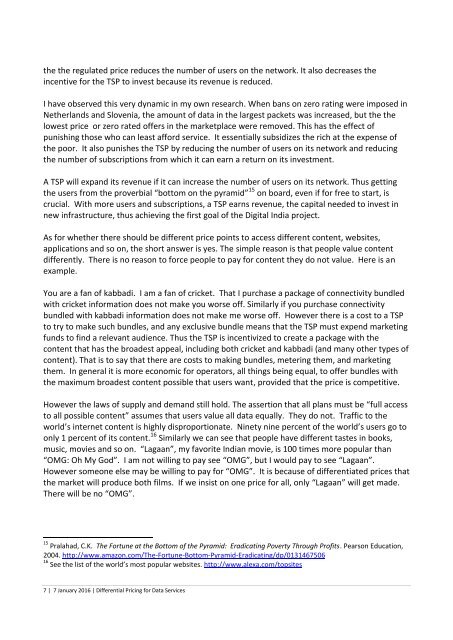Layton
Layton
Layton
You also want an ePaper? Increase the reach of your titles
YUMPU automatically turns print PDFs into web optimized ePapers that Google loves.
the the regulated price reduces the number of users on the network. It also decreases the<br />
incentive for the TSP to invest because its revenue is reduced.<br />
I have observed this very dynamic in my own research. When bans on zero rating were imposed in<br />
Netherlands and Slovenia, the amount of data in the largest packets was increased, but the the<br />
lowest price or zero rated offers in the marketplace were removed. This has the effect of<br />
punishing those who can least afford service. It essentially subsidizes the rich at the expense of<br />
the poor. It also punishes the TSP by reducing the number of users on its network and reducing<br />
the number of subscriptions from which it can earn a return on its investment.<br />
A TSP will expand its revenue if it can increase the number of users on its network. Thus getting<br />
the users from the proverbial “bottom on the pyramid” 15 on board, even if for free to start, is<br />
crucial. With more users and subscriptions, a TSP earns revenue, the capital needed to invest in<br />
new infrastructure, thus achieving the first goal of the Digital India project.<br />
As for whether there should be different price points to access different content, websites,<br />
applications and so on, the short answer is yes. The simple reason is that people value content<br />
differently. There is no reason to force people to pay for content they do not value. Here is an<br />
example.<br />
You are a fan of kabbadi. I am a fan of cricket. That I purchase a package of connectivity bundled<br />
with cricket information does not make you worse off. Similarly if you purchase connectivity<br />
bundled with kabbadi information does not make me worse off. However there is a cost to a TSP<br />
to try to make such bundles, and any exclusive bundle means that the TSP must expend marketing<br />
funds to find a relevant audience. Thus the TSP is incentivized to create a package with the<br />
content that has the broadest appeal, including both cricket and kabbadi (and many other types of<br />
content). That is to say that there are costs to making bundles, metering them, and marketing<br />
them. In general it is more economic for operators, all things being equal, to offer bundles with<br />
the maximum broadest content possible that users want, provided that the price is competitive.<br />
However the laws of supply and demand still hold. The assertion that all plans must be “full access<br />
to all possible content” assumes that users value all data equally. They do not. Traffic to the<br />
world’s internet content is highly disproportionate. Ninety nine percent of the world’s users go to<br />
only 1 percent of its content. 16 Similarly we can see that people have different tastes in books,<br />
music, movies and so on. “Lagaan”, my favorite Indian movie, is 100 times more popular than<br />
“OMG: Oh My God”. I am not willing to pay see “OMG”, but I would pay to see “Lagaan”.<br />
However someone else may be willing to pay for “OMG”. It is because of differentiated prices that<br />
the market will produce both films. If we insist on one price for all, only “Lagaan” will get made.<br />
There will be no “OMG”.<br />
15 Pralahad, C.K. The Fortune at the Bottom of the Pyramid: Eradicating Poverty Through Profits. Pearson Education,<br />
2004. http://www.amazon.com/The-Fortune-Bottom-Pyramid-Eradicating/dp/0131467506<br />
16 See the list of the world’s most popular websites. http://www.alexa.com/topsites<br />
7 | 7 January 2016 | Differential Pricing for Data Services


